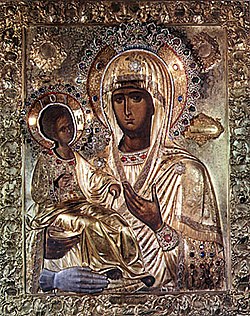Top Qs
Timeline
Chat
Perspective
June 28 (Eastern Orthodox liturgics)
From Wikipedia, the free encyclopedia
Remove ads
June 27 - Eastern Orthodox Church calendar - June 29

All fixed commemorations below celebrated on July 11 by Orthodox Churches on the Old Calendar.[note 1]
For June 28th, Orthodox Churches on the Old Calendar commemorate the Saints listed on June 15.
Saints
- Martyrs Plutarch, Serenus, Heraclides, Heron, Rhaïs, Potamiœna and her mother Marcella, at Alexandria, under Septimius Severus (203)[1][2][3][4][note 2]
- Hieromartyr Donagus, Bishop of Libya, by fire.[3][6][7][8]
- Martyr Macedonius.[3][7][8][9]
- The holy Two Children, who were crucified.[7][10]
- The holy Three Martyrs of Galatia, by the sword.[3][7][11]
- The holy 70 Martyrs of Scythopolis, by the sword.[3][7][8][12]
- Venerable Magnus, who reposed while praying to the Lord.[3][7][13]
- Venerable Moses the Anchorite.[3][7][8][14]
- Saint Vulkian, monk.[2][8]
- Saint Sennuphius the Standard-bearer, of Egypt (late 4th century)[3][15] (see also: March 25 )
- Saint Paul the Physician, of Corinth (7th century)[3][8][15][16][17]
- Saint Sergius the Magistrate, of Paphlagonia, founder of the Nikitiatus Monastery in Nicomedia (866)[2][3][8][15][18]
Remove ads
Pre-Schism Western saints
- Saint Irenaeus of Lyons, a Greek cleric noted for expanding Christian communities in France, combatting heresy and defining Orthodoxy (202)[19][20][note 3][note 4] (see also August 23 )
- Martyr Pappias (Papius), possibly in Sicily, under Diocletian, by beheading (c. 303)[3][7][8][19][21][22][note 5]
- Saint Crummin of Lecua (Crummine), a disciple of St Patrick at Leccuine (Lackan) in Westmeath in Ireland (5th century)[19][23]
- Saint Austell of Cornwall (Austol) (6th century)[3][15][19][note 6]
- Saint Benignus, Bishop of Utrecht in Holland (6th century)[19][note 7][note 8]
- Saint Theodichildis (Theodehilda, Telchildis), a nun at Faremoutiers Abbey in France, she became the first Abbess of Jouarre (c. 660)[19][note 9][note 10]
- Saint Argymirus of Córdoba, martyr (856)[7][19][note 11][note 12]
- Saint Egilo (Egilon, Eigil), a monk and later Abbot of Prüm near Trier in Germany (871)[19][note 13]
- Saint Heimerad (Heimrad), a priest at Baden in Germany who after many pilgrimages lived as a monk at Hersfeld Abbey and then as a hermit at Hasungen in Westphalia (1019)[19][25]
Remove ads
Post-Schism Orthodox saints
- Venerable Xenophon of Robeika, founder of Robeika Monastery, Novgorod (1262)[3][7][15][26][27]
- Saints Sergius and Herman, founders and abbots of Valaam Monastery, Wonderworkers (c. 1353)[3][8][15][27][28][29]
- Saint Heliodorus, Schema-Archimandrite of Glinsk Hermitage (1879)[15]
New martyrs and confessors
Other commemorations
- Translation of the relics (412) of the Holy Wonderworking Unmercenaries and Martyrs Cyrus and John (311)[3][8][15][27][32][33]
- Synaxis of the Icon of the Most Holy Theotokos "Of the Three Hands" of Hilandar ("Trojeručica, Tricherousa"), Mount Athos (8th century)[3][15][27][34][35][note 14] (see also: December 4 )
- Repose of Archimandrite Sophrony (Sakharov) of Essex (1993)[15] (see also: July 11)
- Repose of Archimandrite Methodius (Popovich) of Jerusalem (1997)[15]
Remove ads
Icon gallery
- Martyr Irais of Alexandria.
- St. Irenaeus, Bishop of Lyons.
- St. Xenophon of Robeika.
- Saints Sergius and Herman of Valaam.
- Unmercenaries and Martyrs Cyrus and John.
- Icon of Panagia Tricherousa ("Three-handed Theotokos").
Notes
- The notation Old Style or (OS) is sometimes used to indicate a date in the Julian Calendar (which is used by churches on the "Old Calendar").
The notation New Style or (NS), indicates a date in the Revised Julian calendar (which is used by churches on the "New Calendar"). - "At Alexandria, in the same persecution of Severus, the holy martyrs Plutarch, Serenus, Heraclides, catechumen, Heron, neophyte, another Serenus, Rhais, catechumen, Potamiœena and Marcella, her mother. Among them, the virgin Potamiœna is particularly distinguished. She first endured many most painful trials for the preservation of her virginity, and then cruel and unheard-of torments for the faith, after which she and her mother were consumed with fire."[5]
- Born in Asia Minor, he was a disciple of St Polycarp, who was a disciple of the Apostle John the Divine. He went to France and became Bishop of Lyons (c 177), where he was later martyred. His writings against Gnosticism are a witness to Apostolic Tradition.
- "At Lyons, in France, St. Irenaeus, bishop and martyr, who, as is related by St. Jerome, was the disciple of blessed Polycarp, bishop of Smyrna, and lived near the time of the Apostles. After having strenuously opposed the heretics by speech and writing, he was crowned with a glorious martyrdom, with almost all the people of his city, during the persecution of Severus."[5]
- A disciple of St Mewan or Mevan of Cornwall. He probably lived in the area where the place-name preserves his memory.
- His relics were uncovered there in 996.
- "At Maestricht, St. Benignus, bishop and martyr."[5]
- "Little or nothing is known of this saint, except that she was a daughter of Clovis, king of the Franks; and that she obtained from him a grant of lands at Sens, where she founded the convent of S. Pierre-le-Vif, into which she retired, and where she died."[24]
- See also: Théodechilde (fille de Thierry Ier). Wikipédia. (French Wikipedia).
- Born in Cabra near Cordoba in Spain, he held a high position among the Muslims of the city. He was deprived of his office on account of his faith and became a monk. Shortly afterwards he openly renounced Islam, confessed Christ and was beheaded.
- He restored the monastery at Flavigny near Dijon and founded the monastery of Corbigny, both in France.
- The Damascene Icon of the Mother of God, by ancient tradition, was painted by St John of Damascus in gratitude to the Theotokos for the miraculous healing of his right hand, cut off through the perfidy of Emperor Leo the Isaurian. This icon is also known as "Of the Three Hands" Icon of the Mother of God (June 28, and July 12).
Remove ads
References
Sources
Wikiwand - on
Seamless Wikipedia browsing. On steroids.
Remove ads






